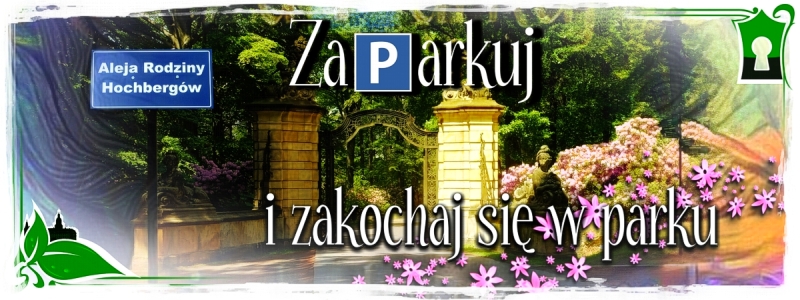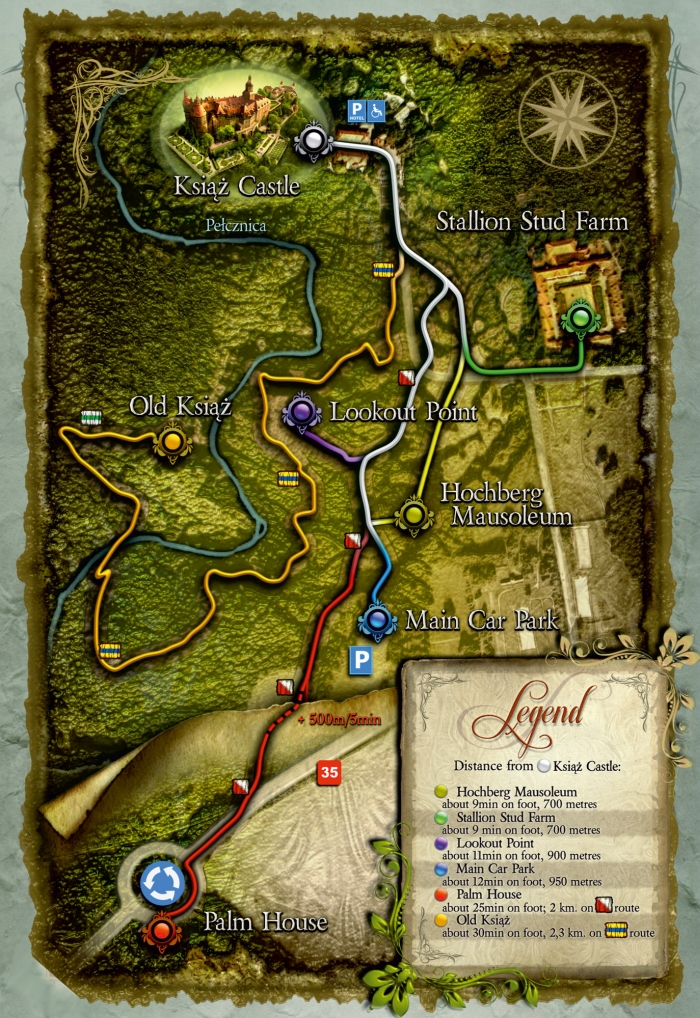The main car park is not only convenient: it’s also a fine starting point for your visit to the Castle surroundings. Please read further to learn what is worth viewing in your 12-minute walk to Książ. A map accompanies the description.

Convenient parking near the Castle: your Książ journey begins here
The main car park is not only convenient: it’s also a fine starting point for your visit to the Castle surroundings. Please read further to learn what is worth viewing in your 12-minute walk to Książ. A map accompanies the description.
Some tourists, wanting to visit Książ quickly, hope to park as close as possible to the Castle. In doing so, they miss out on the remarkable charm of its surroundings, which are in and of themselves an experience for travellers, accessible and well marked.
Visitors are encouraged to leave their cars at the main car park (Parking Główny), on the Castle grounds, about 900 metres from the Castle complex (about 12 minutes by foot). This asphalt-paved car park has numerous parking places. A smooth traffic flow is assured by the separation of entrance and exit roads. These are not, however, its only advantages.
The walk from the main car park to the castle now takes you along part of the “Aleja Rodziny Hochbergów”, the avenue named, on May 17, 2017, after the Hochberg dynasty. It leads through the historic Baroque-era gate (c. 1740), which the Hochbergs had built as one of the architectural features of the Castle park. Protecting the entrance, sphinxes bear pots of flowers and fruit. Why are these mysterious lion-like creatures adorning the gate? During the Baroque period, figures of antiquity often were sources of inspiration, especially for the Hochberg family: their fascination with Greek mythology marks the architecture of the whole complex. This historic gate thus serves as a brilliant introduction to the art of Książ.
Just beyond the gate, visitors will see, on the right side of the avenue, the Hochberg Mausoleum, built in 1734. As of now, it can be admired only from the outside, though soon visitors will be able to enter it, accompanied by a guide. Until 1883, the mausoleum building functioned as the Summer Pavilion, or a scenic lookout point, a place for fun and relaxation in these beautiful natural surroundings. It was later transformed into a burial chapel, and a capacious crypt was carved in the rock. It was there where, among other members of the family, Princess Daisy was laid – for a time. Fearing the approach of the Soviet Red Army in 1945, loyal servants of the Castle’s last aristocratic mistress, renowned in life both for her slim waist and biting tongue, spirited her remains under cover of darkness to an unknown place. The location still awakens a great deal of interest as, according to legend, she lies with her immensely valuable string of pearls, seven metres long.
On the other side of the road that takes visitors to the Castle, a path leads off to the lookout point. The detour is worthwhile: after a few moments, the Castle comes into view, looming like a great ship sailing on a vast, verdant forest ocean. The most popular pictures of Książ, presenting its south face, are taken from this place. This breathtaking view could be described at length; it is better, though, to see it with your own eyes.
The way to the Castle leads through the park, which changes with every new day. As May turns into June, white, yellow and pink rhododendrons – first cultivated here by Princess Daisy -- bloom in huge clusters. In the summer, the Castle surroundings, maintained in the romantic style of an English garden, are in their fullest green. The park’s blaze of colour charms visitors in the autumn, and in winter nature goes to sleep under a silver and white down blanket, which highlights the wonderful forms of the trees and bushes.
Those who are pressed for time may now head directly to the Castle. Others, though, may linger in the spell of Książ’s flora and take the circular road (following the signs) that leads to what is called “Ida’s Gardens” (about two minutes more). In 2015, the park by the Castle was re-developed, and plants that once grew near Książ were brought there. They include the bushes that line the walkways, and extensive patches of park undergrowth. A square greets visitors just before the Castle entrance, featuring a water pool and a sculpture of a female form. Also worthy of notice is the symbolic presentation of Princess Daisy’s legendary necklace, in which the pearls are presented with the help of small boxwood balls.
Our walk along this avenue from the main car park to the Castle, the Aleja Rodziny Hochbergów, comes to an end here – and an even more remarkable adventure begins for you, your journey through the Castle. It might have begun several minutes earlier, but something would have been lost, the part of Książ that is not only wood and stone construction. The surroundings are inseparably tied to the Castle’s remarkable history, with secrets and tales of extraordinary events immersed in this verdant expanse. The story of Książ continues to reveal itself here, and is truly worth discovering.


